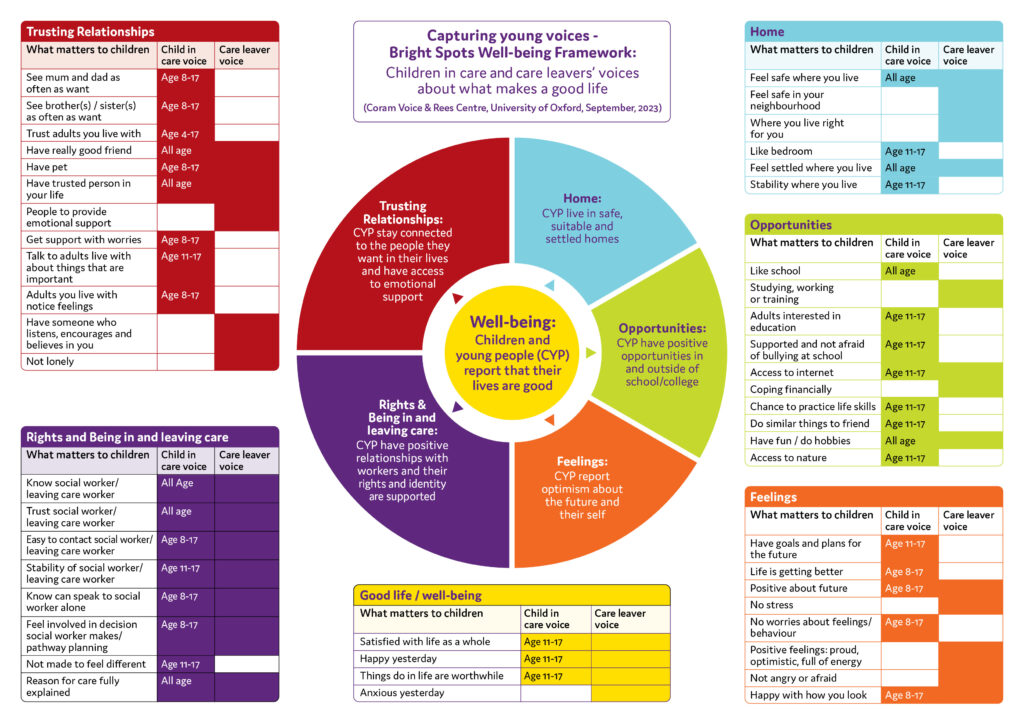 The Bright Spots Programme is a research and service improvement tool that works to ensure that care-experienced children and young people have a say in decisions that impact their lives. Developed by Coram Voice in partnership with Professor Julie Selwyn at the Rees Centre, University of OxfordThe Rees Centre produces research evidence to improve policy and practice in the areas of children’s social care and education. Their aim is to improve the education, well-being and life outcomes of those who are, or have been supported by children’s social care services., with funding from the Hadley TrustThe Hadley Trust is a north London based grant-maker with a focus on disadvantaged people. Grants are predominantly made to support policy and front-line work in the areas of criminal justice and young people, as well as to smaller local charities., the Bright Spots Programme have been working with children in care and care leavers for over a decade to understand what they feel is important to have a good life.
The Bright Spots Programme is a research and service improvement tool that works to ensure that care-experienced children and young people have a say in decisions that impact their lives. Developed by Coram Voice in partnership with Professor Julie Selwyn at the Rees Centre, University of OxfordThe Rees Centre produces research evidence to improve policy and practice in the areas of children’s social care and education. Their aim is to improve the education, well-being and life outcomes of those who are, or have been supported by children’s social care services., with funding from the Hadley TrustThe Hadley Trust is a north London based grant-maker with a focus on disadvantaged people. Grants are predominantly made to support policy and front-line work in the areas of criminal justice and young people, as well as to smaller local charities., the Bright Spots Programme have been working with children in care and care leavers for over a decade to understand what they feel is important to have a good life.
“Bright Spots (a survey of children in care and care leavers) is the best available information we hold, and provides a rich insight into the experiences of children in care and care leavers.”
Independent Review of Children’s Social Care, 2022
The Bright Spots surveys
The two Bright Spots surveys – Your Life, Your Care (for children in care aged 4-17 years) and Your Life Beyond Care (for care leavers aged 16-25 years) – help local authorities to systematically gather the views of their children and young people, and to use the survey findings to influence practice, service development and strategic thinking. Read more about the Bright Spots offer.
Subjective well-being
The surveys ask children and young people about their ‘subjective well-being’: how they feel about their lives at both the individual and interpersonal level.
Asking this question ‘what makes life good?’, helps local authorities to understand how their children in care and care leavers feel as well as what their hopes and feelings are. From this we can deliver high quality services and support that address what they say is most important to them. Read the ‘What Makes Life Good?’ report.
“It’s all about their well-being…and making sure that they are okay, because sometimes young people don’t always say how they feel.” Team Manager, Pathway team
The Bright Spots Well-Being Indicators
The Bright Spots Well-Being Indicators were co-produced with care-experienced children and young people to reflect what they feel make a good life. We ask questions about the indicators in both Bright Spots surveys. The surveys also include some core well-being measures that are used in other national surveys so that we can compare children in care and care leavers’ well-being to young people in the general population. Your survey findings are also compared with those of other local authorities nationally.

The Bright Spots survey questions (indicators) for both children in care and care leavers mapped across the domains.
Bright Spots in your local authority
Each year, we run 20-30 surveys with around 15 local authorities across the UK. Each local authority that takes part in the Bright Spots Programme is supported to plan distribution of their surveys to get the best response rates, and receives a detailed report about how their children in care/ care leavers feel about their lives. Survey findings help local authorities to improve children and young people’s experience by focussing change where they say it is needed. Encouraging decision makers to listen to and act on what their children and young people have to say is a central part of the Bright Spots Programme’s work, both on a local and national level. Contact us to find out more.
“What’s really helpful is that when you get the report, it does that cross-referencing and comparative stuff. I like the fact that obviously the more local authorities that take it up, the more you get that benchmark across other local authority and care populations. So, we have done various kinds of survey type work before…but nothing that’s ever compared to other local authorities.” Assistant Director
Bright Spots – a national focus
The Bright Spots reports provide a rich source of information for both policy and practice. Nationally, the language of the programme has been adopted in the Independent Review of children’s Social Care and in Ofsted’s inspection framework. We are proud to say that our work has been influential in encouraging a greater focus on children and young people’s well-being, and in listening and responding to what they have to say about their lives.
Find all the Bright Spots reports, publications and local authority case studies on our Resource Bank.
